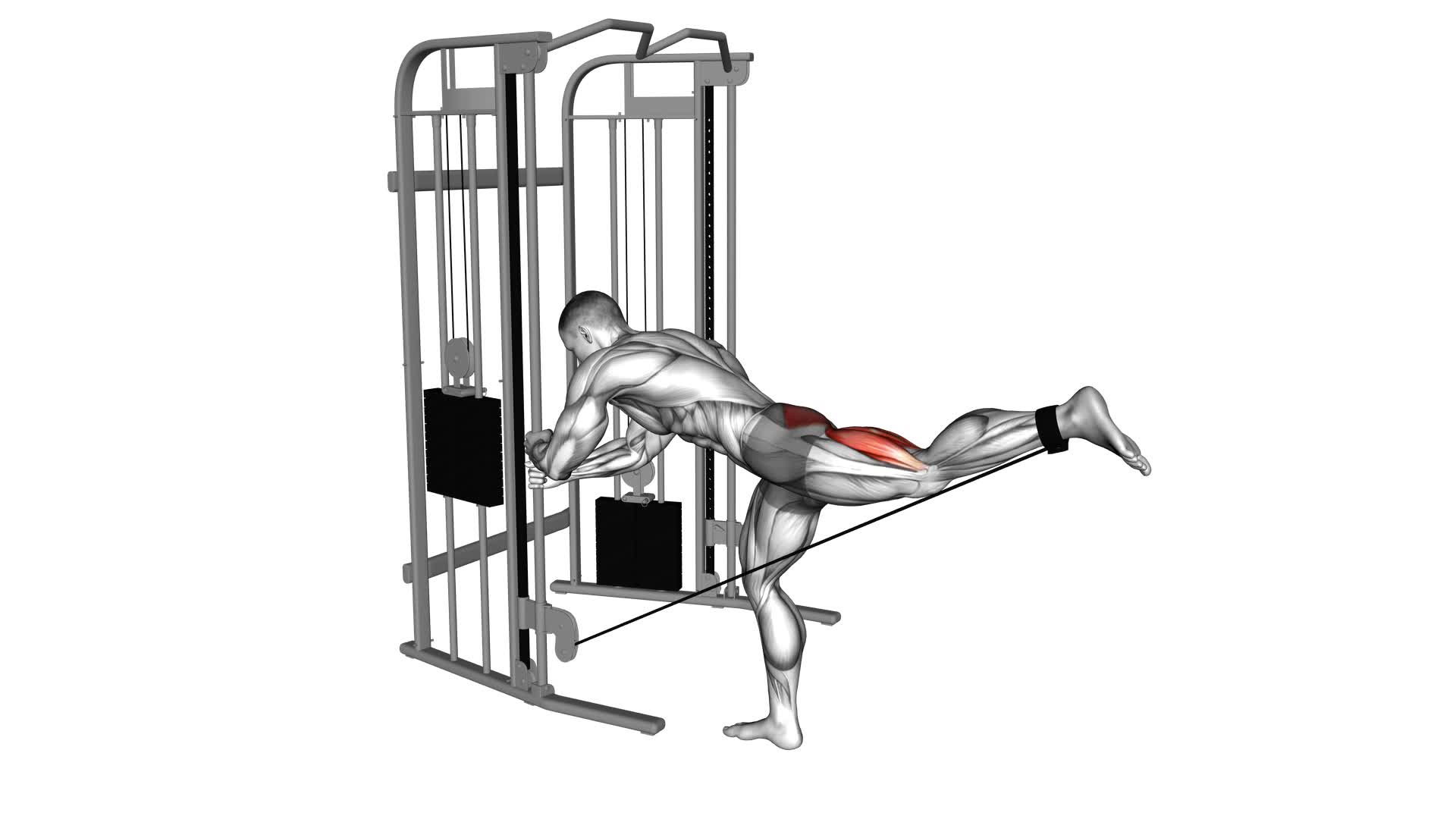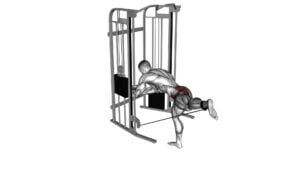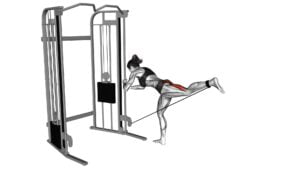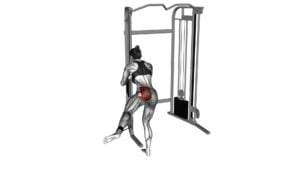Cable Donkey Kickback (male) – Video Exercise Guide & Tips

Get ready to take your workout to the next level with cable donkey kickbacks! This video exercise guide and tips will show you the proper form and technique to target your glutes and hamstrings effectively.
Watch This Exercise Video
With variations and modifications included, you can customize your workout to fit your fitness level. Maximize your results by following these expert tips and avoid common mistakes.
Let's get started and sculpt your lower body with cable donkey kickbacks!
Key Takeaways
- Cable Donkey Kickbacks for men are highly effective for targeting the glutes, hamstrings, and lower back muscles.
- Proper form and technique are crucial to maximize the benefits of Cable Donkey Kickbacks.
- Variations and modifications can be made to target different muscles and intensify the workout.
- Consistency and incorporating Cable Donkey Kickbacks into a full-body workout routine are key for maximizing results.
Benefits of Cable Donkey Kickbacks for Men
You will experience several benefits from incorporating cable donkey kickbacks into your workout routine as a man. Cable donkey kickbacks are a highly effective exercise that target the glutes, hamstrings, and lower back muscles. By performing this exercise regularly, you can expect to see improvements in muscle strength, power, and overall athletic performance.
One of the key benefits of cable donkey kickbacks for men is the development of strong glutes. The gluteus maximus is the largest muscle in the body, and by targeting it with cable donkey kickbacks, you can increase its size and strength. This not only improves your physical appearance but also enhances your ability to perform other exercises, such as squats and deadlifts.
Another benefit of cable donkey kickbacks is improved hip stability. The exercise requires you to engage your core and stabilize your hip joint, which can help prevent injuries and improve your overall balance and coordination.
To ensure you maximize the benefits of cable donkey kickbacks, it's important to maintain proper form and technique. Start by attaching an ankle strap to a low cable pulley and facing away from the machine. Bend your knees slightly and keep your torso upright. Then, kick your leg back while squeezing your glutes at the top of the movement. Make sure to control the weight and avoid swinging your leg or using momentum to perform the exercise.
Incorporating cable donkey kickbacks into your workout routine can provide numerous benefits for men, including increased glute strength, improved hip stability, and enhanced athletic performance. By maintaining proper form and technique, you can safely and effectively reap the rewards of this exercise.
Proper Form and Technique for Cable Donkey Kickbacks
To perform cable donkey kickbacks with proper form and technique, focus on engaging your glutes and maintaining control throughout the exercise. Start by attaching an ankle strap to a low cable pulley and adjusting the weight accordingly. Stand facing the cable machine with your feet hip-width apart and your knees slightly bent. Grab onto a stable object for balance if needed.
As you begin the movement, keep your core engaged and your back straight. Slowly extend your right leg back while squeezing your glutes. Your leg should be straight but not locked. Pause at the top of the movement and squeeze your glutes even more. Slowly return your leg to the starting position and repeat the exercise on the opposite side.
It's important to avoid common mistakes when performing cable donkey kickbacks. One common mistake is using momentum to swing your leg up instead of relying on your glute muscles. This reduces the effectiveness of the exercise and increases the risk of injury. Another mistake is arching your back or rounding your shoulders. Remember to maintain proper posture throughout the movement.
The benefits of cable donkey kickbacks include targeting and strengthening your glute muscles, which can help improve your overall lower body strength and stability. Additionally, this exercise can also help improve balance and coordination. By focusing on engaging your glutes and maintaining control throughout the exercise, you can maximize the benefits while minimizing the risk of injury.
Variations and Modifications for Cable Donkey Kickbacks
For more challenging and diverse workouts, consider incorporating different variations and modifications into your cable donkey kickbacks routine. By adding variations and progressions to your exercise, you can target different muscles and intensify your workout. Here are three options to try:
- Single-leg cable donkey kickbacks: Instead of using both legs simultaneously, perform the exercise with one leg at a time. This variation increases the demand on your glutes and hamstrings, as well as your core stability. Start with a lighter weight and focus on maintaining proper form and control throughout the movement.
- Cable donkey kickbacks with resistance bands: Attach a resistance band just above your knees and perform the exercise as usual. The resistance band adds an extra challenge by activating the muscles of the outer hips and thighs. This variation helps improve hip stability and strengthens the muscles responsible for stabilizing your knees.
- Cable donkey kickbacks with ankle weights: Secure ankle weights around your ankles before starting the exercise. The additional weight increases the resistance, making your glutes and hamstrings work harder. Start with lighter weights and gradually increase as your strength improves.
Incorporating these variations and progressions into your cable donkey kickbacks routine can help you challenge your muscles in new ways and achieve better results. Remember to always listen to your body and choose the options that feel comfortable and safe for you.
Tips for Maximizing Results With Cable Donkey Kickbacks
To optimize the effectiveness of your cable donkey kickbacks, it's important to implement these tips into your routine.
First and foremost, consider incorporating cable donkey kickbacks into a full-body workout. This exercise primarily targets the glutes, but it also engages the core and lower back muscles for stability. By including it in a comprehensive routine, you can maximize the benefits and work multiple muscle groups simultaneously.
Another crucial aspect to consider is the principle of progressive overload. This principle states that to continue seeing results, you must gradually increase the demands placed on your muscles. With cable donkey kickbacks, you can achieve progressive overload by gradually increasing the weight or resistance used. Start with a comfortable weight that allows you to perform the exercise with proper form, and then gradually increase the weight as you get stronger. This will challenge your muscles and stimulate further growth and strength development.
Common Mistakes to Avoid When Performing Cable Donkey Kickbacks
When performing cable donkey kickbacks, be mindful of the following common mistakes to avoid:
- Incorrect form: One of the most common mistakes is using improper form during cable donkey kickbacks. To ensure proper muscle activation and avoid injury, it's important to maintain a neutral spine throughout the exercise. Avoid arching your back or rounding your shoulders. Instead, engage your core and keep your back straight.
- Lifting too much weight: Another mistake to avoid is selecting a weight that's too heavy. While it's important to challenge yourself, using excessive weight can compromise your form and reduce the effectiveness of the exercise. Start with a weight that allows you to perform the movement with control and proper technique.
- Relying on momentum: Many people make the mistake of relying on momentum rather than focusing on muscle activation. To get the most out of cable donkey kickbacks, it's crucial to control the movement and avoid swinging or using momentum to lift the weight. Instead, concentrate on squeezing your glutes as you extend your leg backward.
Frequently Asked Questions
What Is the Recommended Number of Sets and Repetitions for Cable Donkey Kickbacks?
For cable donkey kickbacks, the recommended number of sets and repetitions depends on your fitness level and goals. Generally, it's recommended to start with 2-3 sets of 10-12 repetitions.
As you become stronger, you can increase the number of sets or repetitions. Cable donkey kickbacks are an effective exercise for developing your glutes. They target your gluteus maximus, helping to strengthen and tone your buttocks.
Can Cable Donkey Kickbacks Help in Building Overall Leg Strength?
Cable donkey kickbacks are a great exercise for glute activation and can definitely help in building overall leg strength. By targeting the glutes, this exercise can improve your athletic performance and power. It's a popular choice among athletes for its ability to strengthen the posterior chain and improve hip extension.
Incorporating cable donkey kickbacks into your workout routine can provide numerous benefits, including increased stability, power, and explosiveness in your legs.
Are There Any Specific Muscles Targeted by Cable Donkey Kickbacks?
When it comes to cable donkey kickbacks, there are specific muscles that are targeted during this exercise. By incorporating cable donkey kickbacks into your lower body workout routine, you can benefit from increased activation of your glutes and hamstrings.
To properly execute this exercise for maximum muscle activation, make sure to maintain proper form and control throughout the movement. By doing so, you can effectively target and strengthen these specific muscles in your lower body.
Can Cable Donkey Kickbacks Be Performed Using Different Attachments or Handles?
Yes, cable donkey kickbacks can be performed using different attachments or handles. This allows for different variations of the exercise and can target different muscles.
The benefits of cable exercises include increased stability, improved muscle activation, and the ability to adjust resistance easily.
Using different attachments or handles can also challenge your muscles in new ways and prevent plateaus in your workout routine.
Is It Necessary to Warm up Before Performing Cable Donkey Kickbacks?
Before performing cable donkey kickbacks, it's necessary to warm up. Incorporating warm-up exercises before any workout routine has numerous benefits. It helps increase blood flow and oxygen to the muscles, improves flexibility and range of motion, and reduces the risk of injury.
If you're looking for alternatives to cable donkey kickbacks for targeting the glute muscles, there are exercises like hip thrusts, lunges, and squats that can be equally effective.
Conclusion
In conclusion, cable donkey kickbacks are a beneficial exercise for men that target the glutes and hamstrings. By maintaining proper form and technique, men can effectively engage these muscle groups and enhance their lower body strength.
Variations and modifications can be incorporated to add variety and challenge to the exercise. By following these tips and avoiding common mistakes, men can maximize their results and achieve a stronger, more toned lower body.
So, add cable donkey kickbacks to your workout routine for impressive gains.

Author
Years ago, the spark of my life’s passion ignited in my mind the moment I stepped into the local gym for the first time. The inaugural bead of perspiration, the initial endeavor, the very first surge of endorphins, and a sense of pride that washed over me post-workout marked the beginning of my deep-seated interest in strength sports, fitness, and sports nutrition. This very curiosity blossomed rapidly into a profound fascination, propelling me to earn a Master’s degree in Physical Education from the Academy of Physical Education in Krakow, followed by a Sports Manager diploma from the Jagiellonian University. My journey of growth led me to gain more specialized qualifications, such as being a certified personal trainer with a focus on sports dietetics, a lifeguard, and an instructor for wellness and corrective gymnastics. Theoretical knowledge paired seamlessly with practical experience, reinforcing my belief that the transformation of individuals under my guidance was also a reflection of my personal growth. This belief holds true even today. Each day, I strive to push the boundaries and explore new realms. These realms gently elevate me to greater heights. The unique combination of passion for my field and the continuous quest for growth fuels my drive to break new ground.







